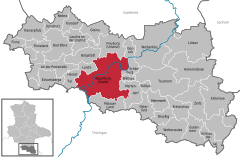Naumburg
| Naumburg | ||
|---|---|---|

Naumburg Cathedral
|
||
|
||
| Coordinates: 51°9′N 11°49′E / 51.150°N 11.817°ECoordinates: 51°9′N 11°49′E / 51.150°N 11.817°E | ||
| Country | Germany | |
| State | Saxony-Anhalt | |
| District | Burgenlandkreis | |
| Government | ||
| • Mayor | Bernward Küper (CDU) | |
| Area | ||
| • Total | 129.88 km2 (50.15 sq mi) | |
| Elevation | 130 m (430 ft) | |
| Population (2015-12-31) | ||
| • Total | 33,012 | |
| • Density | 250/km2 (660/sq mi) | |
| Time zone | CET/CEST (UTC+1/+2) | |
| Postal codes | 06618, 06628 | |
| Dialling codes | 03445, 034466, 034463 | |
| Vehicle registration | BLK | |
| Website | www.naumburg.de | |
| Bishopric of Naumburg-Zeitz | ||||||||||
| Bistum Naumburg-Zeitz | ||||||||||
| State of the Holy Roman Empire | ||||||||||
|
||||||||||
| Capital | Naumburg | |||||||||
| Government | Principality | |||||||||
| Historical era | Middle Ages | |||||||||
| • | Established | 1029 | ||||||||
| • | Secularised to Saxony | 1565 | ||||||||
|
||||||||||
Naumburg (German pronunciation: [ˈnaʊmbʊɐ̯k]) is a town in (and the administrative capital of) the district Burgenlandkreis, in the state of Saxony-Anhalt, Germany. It has a population of around 33,000.
The first written record of Naumburg dates from 1012, when it was mentioned as the new castle of the Ekkehardinger, the Margrave of Meissen. It was founded at the crossing of two trade-routes. The successful foundation not long beforehand of a Propstei Church on the site of the later Naumburg Cathedral was mentioned in the Merseburg Bishops' Chronicles in 1021. In 1028 Pope John XIX gave his approval for the transfer of the bishopric from Zeitz to Naumburg. Until 1568, during the Reformation, Naumburg was the seat of the bishops. The last Catholic bishop was Julius von Pflug. The foundation of the cathedral school is dated to 1030. Naumburg has been known as a town since 1144.
Naumburg was a significant trading centre on the Via Regia in the Middle Ages, especially because of the Naumburg Trade Fairs, first known to have taken place in 1278. The emergence of Leipzig as a trade-fair centre from 1500 and the Thirty Years' War adversely affected the Naumburg economy.
The ecclesiastical domain was secularised in middle of the 16th century and transferred to the Dukes of Saxony, who administered the district through a government endowment (Stiftsregierung) and later provided administrators.
After the fraternal agreement between the four brothers of John George I, Elector of Saxony, in 1657 the Naumburg district came into the possession of the secondogeniture of Saxe-Zeitz, which was inherited by Moritz, the youngest of the brothers.
Before the Moritzburg castle was built in nearby Zeitz, the city castle in Naumburg served as the residence of this line. This period came to an end with the death of the last Protestant representative of the Saxe-Zeitz line in the year 1718. The Naumburg district reverted to the Dukes of Saxony in Dresden and became fully integrated into Albertine Saxony. However, it remained until 1815 the seat of its own administrative authority (Consistory of the district of Naumburg-Zeitz). After the Congress of Vienna in 1815, Naumburg was ceded to the Kingdom of Prussia, becoming part of the Province of Saxony. It gained control over the cathedral and its close in 1832.
...
Wikipedia




